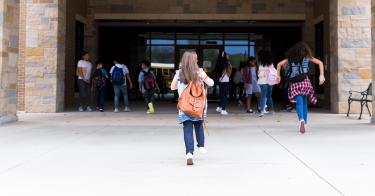Since the pandemic, teachers have reported that students are fighting more at school. Educators are struggling to maintain order. Yet in a new report, the Department of Education is advising school officials to focus on “equity” in school discipline policies—offering little help for educators trying to protect students and help them succeed in the classroom.
Last week, the department issued a set of “guiding principles” on student discipline. These principles revive dubious research and echo thinly veiled threats from Washington that micromanaged school policies a decade ago.
In 2014, President Barack Obama’s departments of Justice and Education wrote a letter to schools stating that if teachers suspended or expelled minority students more than their peers, regardless of the behavior that led to the sanction, their schools should expect a visit from the Office for Civil Rights.
Such visits mean paperwork, potential litigation, or worse, embarrassing headlines in the local news media. The Education Department’s new report once again decries the “disproportionate use and overuse of exclusionary discipline policies [suspension or expulsion]” on minority students and calls for educators to implement “restorative justice.”
>>> Parents Are Fed Up With Public Schools Secretly Transitioning Children
The department failed to mention that some of the very studies the agency originally cited in 2014 in support of eliminating suspensions and expulsions also said, “In and of itself, disproportionate representation in school discipline is not sufficient to prove bias.” Still, the department implies through clever characterization that teacher racism causes disciplinary disparities.
But for years, the Institute of Education Sciences’ Report on Indicators of School Crime and Safety has found higher incidences of fights on school property, drug use and gang activity among Black and Hispanic students—which should prompt different discipline for the sake of protecting innocent students regardless of race. The latest numbers find that nearly 16% of Black high school students reported being in a physical fight at school, compared with 6% of White students and 8% of Hispanic students.
In my testimony before the Federal Commission on School Safety in 2018, convened after the fatal shootings at a Broward County, Florida, high school, I said that teachers must feel empowered to protect students from their disruptive peers. Each incident involving student discipline should be judged on the merits. The commission’s final report said educators know schools and students best and should make decisions on school safety without fear of “undue federal repercussions.”
The agency’s new guidelines, though, push teachers to opt for restorative justice while limiting the use of school resource officers. Any instance of a security officer becoming abusive with a K-12 student deserves investigation, but when there were 1.4 million criminal incidents in public schools in 2019-20 (the last year for which we have data), clearly the need remains for well-trained school resource officers.
Meanwhile, the department’s call for restorative justice is misguided. “Restorative justice” is loosely defined in the literature and generally means that disruptive students do not face suspension or expulsion, even if they’re repeatedly violent. Instead, they meet and discuss violent episodes with students or teachers whom they have bullied or attacked.
>>> Parents’ Bill of Rights Is How Congress Can Help State School Reformers
Research from Los Angeles, Philadelphia, Pittsburgh and Maine found that restorative justice has mixed effects at best, and negative effects on some students. Student achievement declined among minority students in some studies—the very students the department is concerned with—while the practices led to worse reports on school climate and bullying in others.
Some states are moving in the opposite direction from the administration, which may have prompted the Education Department’s latest missive. Nevada lawmakers are considering a proposal that restores teachers’ authority to protect students from peers who become violent. Notably, teachers union members—usually in lockstep with the Biden administration—support the revisions. In Kentucky, Gov. Andy Beshear recently approved a proposal that gives school leaders more authority to suspend or expel repeatedly disruptive and violent students.
Research and state policies point to letting teachers and school officials, in coordination with parents, make decisions about how to protect students. This approach does not square with the Biden administration’s “equity” agenda, but it appropriately puts student safety over political ideology.
This piece originally appeared in The Washington Times




